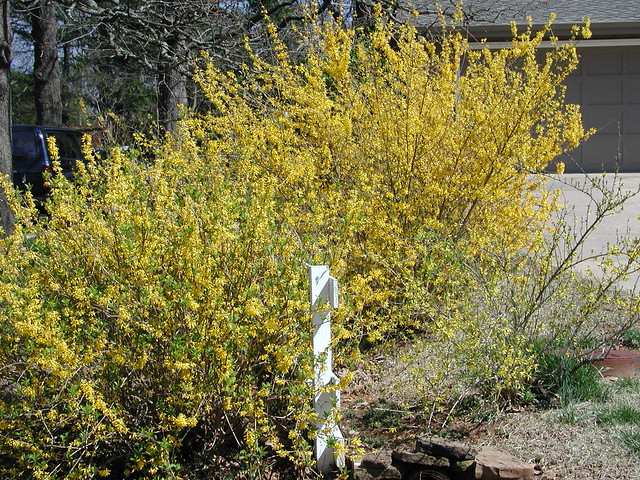Resource Library
Plant of the Week: Forsythia
I love forsythia, for they mark the boundary line between winter and spring. In the Fayetteville, Ark. area, they usually bloom between March 10 and 20 and, though killing frosts are not uncommon after that date, the worst of winter is always behind. This most common of shrubs is maligned by garden writers for its short season of interest, misused in landscape plantings where its large spreading form is shoehorned into a space that is too small, and generally abused by homeowners who prune it as if it were a giant bowling ball.
To get the maximum benefit from these beautiful deciduous shrubs, their true nature must first be recognized. The largest are 8-10 feet tall and sprawl 10-12 feet across if left unpruned. Plant size can be contained, but it is difficult to keep them smaller than half their natural size without resorting to constant shearing — which destroys the beauty of the shrub. Landscapes that lack the space for these giants should consider planting one of the dwarf forms now available.
“Lynwood Gold” is the most common forsythia I see in nurseries. It has large, 1.5-inch golden flowers and long, stout canes that are cloaked with flowers up and down the stem. “Spring Glory” blooms five days earlier than “Lynwood Gold” and has flowers that are more yellow than gold. “Spectabilis” was introduced in 1906, and though not as showy as either of the two above, is still offered.
The selections listed above are big plants that need room to grow and develop. They should be planted where they get at least 6 hours of sunlight and can be largely left alone for several years until such time as severe pruning can be used just after flowering to shrink their dimensions.
“Golden Times,” a selection of F. giraldiana, has done well in a Botanical Garden of the Ozarks planting. It grows 6 feet tall and wide, flowers profusely for us and has yellow and cream variegated leaves that hold their color well during most of the summer. “KolGold” (Magical® Gold) is an upright grower to 6 feet tall with long, erect stems and stout, quarter-size blooms that was developed in Germany for use in the cut flower market.
The dwarf forsythias are under 4 feet tall and are becoming more common in nurseries. Of the ones I have grown Gold Tide® is the best. A 10-year-old plant is about 3 feet tall and 5 feet wide and flowers heavily each spring. Show Off™, in five years, has only grown about 2 feet tall and wide, and may one day make a nice forsythia, but so far it seems stiff and ungainly with wands of short yellow stems when it blooms.
When selecting any shrub for the garden it is important to know how large it will grow. Because forsythia offer so much more in the garden if pruning can be minimized, selecting a clone of the right size is essential.
For more information about horticulture or to see other Plant of the Week columns, visit Extension's Web site, www.uaex.uada.edu, or contact your county extension agent. The Cooperative Extension Service is part of the U of A Division of Agriculture.
Pursuant to 7 CFR § 15.3, the University of Arkansas System Division of Agriculture offers all its Extension and Research programs and services (including employment) without regard to race, color, sex, national origin, religion, age, disability, marital or veteran status, genetic information, sexual preference, pregnancy or any other legally protected status, and is an equal opportunity institution.
